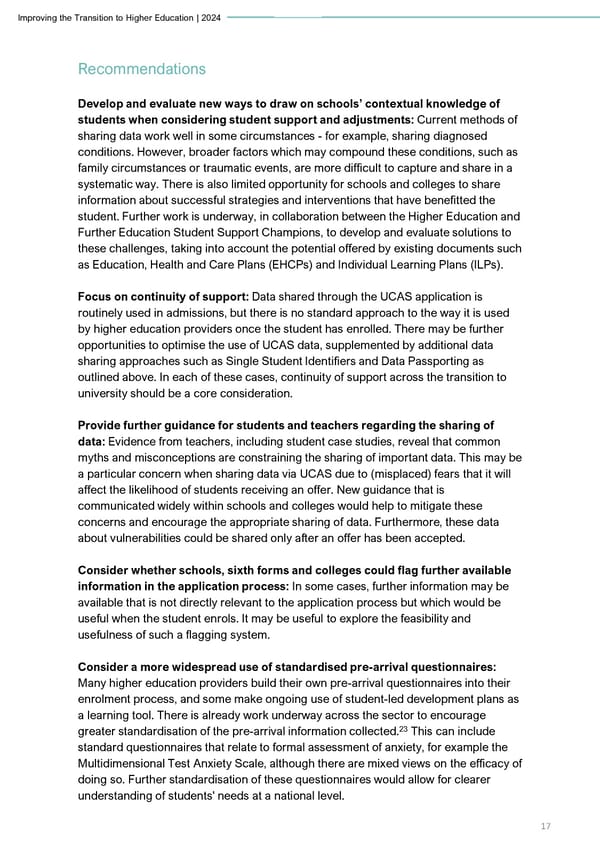Improving the Transition to Higher Education | 2024 Internal Recommendations Develop and evaluate new ways to draw on schools9 contextual knowledge of students when considering student support and adjustments: Current methods of sharing data work well in some circumstances - for example, sharing diagnosed conditions. However, broader factors which may compound these conditions, such as family circumstances or traumatic events, are more difficult to capture and share in a systematic way. There is also limited opportunity for schools and colleges to share information about successful strategies and interventions that have benefitted the student. Further work is underway, in collaboration between the Higher Education and Further Education Student Support Champions, to develop and evaluate solutions to these challenges, taking into account the potential offered by existing documents such as Education, Health and Care Plans (EHCPs) and Individual Learning Plans (ILPs). Focus on continuity of support: Data shared through the UCAS application is routinely used in admissions, but there is no standard approach to the way it is used by higher education providers once the student has enrolled. There may be further opportunities to optimise the use of UCAS data, supplemented by additional data sharing approaches such as Single Student Identifiers and Data Passporting as outlined above. In each of these cases, continuity of support across the transition to university should be a core consideration. Provide further guidance for students and teachers regarding the sharing of data: Evidence from teachers, including student case studies, reveal that common myths and misconceptions are constraining the sharing of important data. This may be a particular concern when sharing data via UCAS due to (misplaced) fears that it will affect the likelihood of students receiving an offer. New guidance that is communicated widely within schools and colleges would help to mitigate these concerns and encourage the appropriate sharing of data. Furthermore, these data about vulnerabilities could be shared only after an offer has been accepted. Consider whether schools, sixth forms and colleges could flag further available information in the application process: In some cases, further information may be available that is not directly relevant to the application process but which would be useful when the student enrols. It may be useful to explore the feasibility and usefulness of such a flagging system. Consider a more widespread use of standardised pre-arrival questionnaires: Many higher education providers build their own pre-arrival questionnaires into their enrolment process, and some make ongoing use of student-led development plans as a learning tool. There is already work underway across the sector to encourage 23 greater standardisation of the pre-arrival information collected. This can include standard questionnaires that relate to formal assessment of anxiety, for example the Multidimensional Test Anxiety Scale, although there are mixed views on the efficacy of doing so. Further standardisation of these questionnaires would allow for clearer understanding of students' needs at a national level. 17
 Improving the transition to Higher Education Page 16 Page 18
Improving the transition to Higher Education Page 16 Page 18